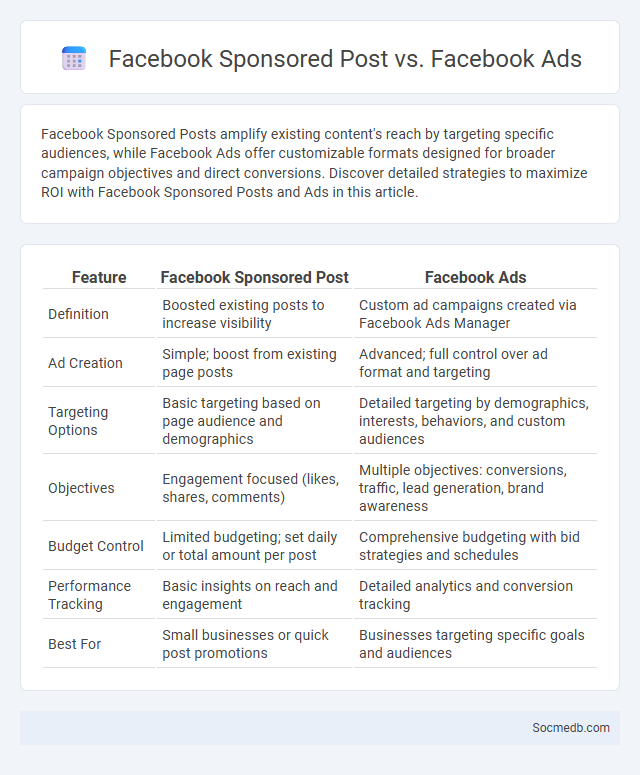
Photo illustration: Facebook Sponsored Post vs Facebook Ads
Facebook Sponsored Posts amplify existing content's reach by targeting specific audiences, while Facebook Ads offer customizable formats designed for broader campaign objectives and direct conversions. Discover detailed strategies to maximize ROI with Facebook Sponsored Posts and Ads in this article.
Table of Comparison
| Feature | Facebook Sponsored Post | Facebook Ads |
|---|---|---|
| Definition | Boosted existing posts to increase visibility | Custom ad campaigns created via Facebook Ads Manager |
| Ad Creation | Simple; boost from existing page posts | Advanced; full control over ad format and targeting |
| Targeting Options | Basic targeting based on page audience and demographics | Detailed targeting by demographics, interests, behaviors, and custom audiences |
| Objectives | Engagement focused (likes, shares, comments) | Multiple objectives: conversions, traffic, lead generation, brand awareness |
| Budget Control | Limited budgeting; set daily or total amount per post | Comprehensive budgeting with bid strategies and schedules |
| Performance Tracking | Basic insights on reach and engagement | Detailed analytics and conversion tracking |
| Best For | Small businesses or quick post promotions | Businesses targeting specific goals and audiences |
Understanding Facebook Sponsored Posts
Facebook Sponsored Posts boost your content visibility by targeting specific audiences based on demographics, interests, and behavior. These posts function as paid advertisements that appear seamlessly in users' newsfeeds, enhancing engagement and driving traffic. Effective use of Facebook's Ad Manager allows you to optimize budget allocation and monitor real-time performance metrics for maximum return on investment.
What are Facebook Ads?
Facebook Ads are targeted advertising campaigns designed to reach specific audiences based on demographics, interests, and behaviors on the Facebook platform. These ads utilize Facebook's robust data analytics and machine learning algorithms to optimize ad delivery and increase engagement, conversions, and brand awareness. Businesses leverage Facebook Ads to promote products, services, or events through various formats including image, video, carousel, and slideshow ads.
Defining Sponsored Posts: Beyond Facebook
Sponsored posts extend beyond Facebook to platforms like Instagram, Twitter, LinkedIn, and TikTok, where businesses pay to promote content targeting specific audiences. These posts blend seamlessly with organic content while containing clear disclosures to maintain transparency and trust. Understanding how your sponsored posts function across different social networks maximizes reach and engagement effectively.
Key Differences: Sponsored Posts vs Facebook Ads
Sponsored posts appear within your social media feed and blend seamlessly with organic content, offering a native advertising experience that boosts visibility without interrupting user engagement. Facebook Ads provide advanced targeting options, customizable formats, and detailed analytics to optimize campaign performance and reach specific audience segments more precisely. Your choice between these two should align with your marketing goals, whether aiming for subtle brand awareness or direct response and conversion.
Targeting Capabilities: Which Is More Precise?
Social media platforms offer sophisticated targeting capabilities, with Facebook and Instagram leading in precision due to their extensive user data and advanced algorithms that allow targeting by demographics, interests, behaviors, and location. LinkedIn excels in professional targeting, providing more accuracy for B2B marketing by enabling filters based on job title, industry, and company size. Your choice depends on your audience, but for granular consumer targeting, Facebook's multidimensional profiles generally offer the most precise options.
Budget and Cost Comparison
Social media marketing budgets vary widely, with businesses typically allocating 9-13% of their total marketing spend to platforms like Facebook, Instagram, and LinkedIn. Cost per click (CPC) rates range from $0.20 to $6.00 depending on the industry and targeting specifics, while cost per impression (CPM) averages between $5 and $12. Comparing these expenses highlights the importance of aligning budget with campaign goals to maximize return on investment (ROI) and optimize ad spend efficiency.
Engagement and Reach: How Do They Compare?
Engagement measures user interactions such as likes, comments, shares, and clicks, reflecting how actively an audience connects with content, while reach quantifies the total number of unique users exposed to a post. High engagement indicates strong audience interest and content relevance, often leading to improved organic reach due to platform algorithms prioritizing interactive posts. Brands prioritizing both metrics can optimize social media strategies by balancing content visibility and meaningful user participation to maximize marketing impact.
Content Format Options and Flexibility
Social media platforms offer diverse content format options including text posts, images, videos, stories, and live streams, enabling brands to tailor messages to specific audience preferences. Flexibility in content formats facilitates engagement by allowing real-time interaction, immersive storytelling, and dynamic visual presentations, enhancing user experience and brand visibility. Leveraging varied formats like carousel ads, reels, and IGTV optimizes reach across multiple demographics and social media algorithms.
Use Cases: When to Choose Each Option
Social media platforms offer distinct use cases tailored to different goals: LinkedIn excels for professional networking and B2B marketing, Instagram drives visual storytelling and brand awareness, while Twitter is ideal for real-time news and customer engagement. Your choice depends on whether you aim to build industry connections, showcase products visually, or communicate instant updates to your audience. Understanding each platform's strengths ensures you target your marketing efforts effectively and maximize user engagement.
Final Verdict: Choosing the Best for Your Campaign
Selecting the best social media platform for your campaign revolves around identifying where your target audience is most active and engaged. Analyzing platform-specific metrics, such as user demographics, content formats, and engagement rates, will maximize campaign effectiveness and ROI. Tailoring your strategy to align with the strengths of Facebook, Instagram, LinkedIn, or TikTok ensures Your campaign reaches the right users with optimized content.
 socmedb.com
socmedb.com